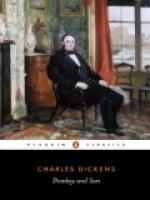|
This section contains 709 words (approx. 2 pages at 400 words per page) |

|
Point of View
Dombey and Son is narrated by a third person, omniscient narrator who often veers into free indirect discourse. This third person, omniscient narrator is able to describe the thoughts, words, and actions of multiple characters, switching between characters, locations, and intersecting storylines in each chapter. The narrator has a distinct perspective, though, often poking fun at characters, signaling which characters not to trust, and helping the reader build sympathy with others.
Though the narrator in Dombey and Son usually describes the characters’s feelings from an outside perspective, it sometimes uses free indirect discourse. Free indirect discourse, or free indirect speech, is when the narrator speaks in the voice and perspective of a character temporarily without any direct sign that the perspective has changed. Free indirect discourse allows the reader to get into a character’s head, giving all of the intimacy of first person...
|
This section contains 709 words (approx. 2 pages at 400 words per page) |

|




